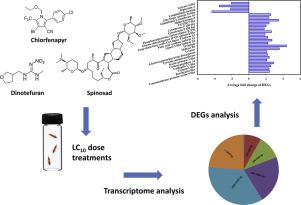当前位置:
X-MOL 学术
›
Pestic. Biochem. Phys.
›
论文详情
Our official English website, www.x-mol.net, welcomes your
feedback! (Note: you will need to create a separate account there.)
Transcriptomic identification and characterization of genes responding to sublethal doses of three different insecticides in the western flower thrips, Frankliniella occidentalis
Pesticide Biochemistry and Physiology ( IF 4.2 ) Pub Date : 2020-07-01 , DOI: 10.1016/j.pestbp.2020.104596 Yue Gao 1 , Min Ju Kim 1 , Ju Hyeon Kim 2 , In Hong Jeong 3 , J Marshall Clark 4 , Si Hyeock Lee 5
Pesticide Biochemistry and Physiology ( IF 4.2 ) Pub Date : 2020-07-01 , DOI: 10.1016/j.pestbp.2020.104596 Yue Gao 1 , Min Ju Kim 1 , Ju Hyeon Kim 2 , In Hong Jeong 3 , J Marshall Clark 4 , Si Hyeock Lee 5
Affiliation

|
Pretreatment with sublethal concentrations (LC10) of three insecticides (chlorfenapyr, dinotefuran, and spinosad) enhanced tolerance to a lethal dose of the respective insecticide in the Western flower thrips, Frankliniella occidentalis. To identify genes responding to sublethal treatment with insecticides, transcriptome analysis was conducted for thrips treated with LC10 of the three insecticides. When based on a fold change >1.5 or < -1.5 as a selection criterion, 199 transcripts were commonly up-regulated, whereas 31 transcripts were commonly down-regulated following all three insecticide treatments. The differential expression levels of representative genes were validated by quantitative PCR. Most over-transcribed transcripts could be categorized as basic biological processes, such as proteolysis and lipid metabolism. Detoxification genes, such as one glutathione S transferase S1, three UDP-glucuronosyltransferases, four CYP450s, and one ABC transporter G family member 20, were commonly overexpressed in all three insecticide-treated groups. Knockdown of the five representative commonly overexpressed genes via ingestion RNA interference increased mortalities to all the three test insecticides, supporting their common role in tolerance induction. In contrast, three C2H2-type zinc finger-containing proteins were significantly down-regulated in all insecticide-treated thrip groups. Since the tested insecticides have distinct structures and modes of action, the roles of commonly expressed genes in tolerance were discussed.
中文翻译:

西部花蓟马中三种不同杀虫剂亚致死剂量响应基因的转录组学鉴定和表征
用亚致死浓度 (LC10) 的三种杀虫剂(氯芬吡、呋虫胺和多杀菌素)进行预处理可增强西花蓟马 Frankliniella occidentalis 对相应杀虫剂致死剂量的耐受性。为了鉴定对杀虫剂亚致死处理有反应的基因,对用三种杀虫剂中的 LC10 处理的蓟马进行转录组分析。当基于倍数变化 >1.5 或 <-1.5 作为选择标准时,199 个转录本通常被上调,而 31 个转录本在所有三种杀虫剂处理后通常被下调。代表性基因的差异表达水平通过定量 PCR 进行验证。大多数过度转录的转录本可以归类为基本的生物过程,例如蛋白水解和脂质代谢。解毒基因,例如一种谷胱甘肽 S 转移酶 S1、三种 UDP-葡萄糖醛酸转移酶、四种 CYP450 和一种 ABC 转运蛋白 G 家族成员 20,通常在所有三个杀虫剂处理组中过度表达。通过摄入 RNA 干扰敲除五个代表性的常见过度表达基因会增加所有三种测试杀虫剂的死亡率,支持它们在耐受诱导中的共同作用。相比之下,三种 C2H2 型含锌指蛋白在所有杀虫剂处理的蓟马组中均显着下调。由于测试的杀虫剂具有不同的结构和作用方式,因此讨论了常见表达基因在耐受性中的作用。在所有三个杀虫剂处理组中通常过表达。通过摄入 RNA 干扰敲除五个代表性的常见过度表达基因会增加所有三种测试杀虫剂的死亡率,支持它们在耐受诱导中的共同作用。相比之下,三种 C2H2 型含锌指蛋白在所有杀虫剂处理的蓟马组中均显着下调。由于测试的杀虫剂具有不同的结构和作用方式,因此讨论了常见表达基因在耐受性中的作用。在所有三个杀虫剂处理组中通常过表达。通过摄入 RNA 干扰敲除五个代表性的常见过度表达基因会增加所有三种测试杀虫剂的死亡率,支持它们在耐受诱导中的共同作用。相比之下,三种 C2H2 型含锌指蛋白在所有杀虫剂处理的蓟马组中均显着下调。由于测试的杀虫剂具有不同的结构和作用方式,因此讨论了常见表达基因在耐受性中的作用。在所有杀虫剂处理的蓟马组中,三种 C2H2 型含锌指蛋白均显着下调。由于测试的杀虫剂具有不同的结构和作用方式,因此讨论了常见表达基因在耐受性中的作用。在所有杀虫剂处理的蓟马组中,三种 C2H2 型含锌指蛋白均显着下调。由于测试的杀虫剂具有不同的结构和作用方式,因此讨论了常见表达基因在耐受性中的作用。
更新日期:2020-07-01
中文翻译:

西部花蓟马中三种不同杀虫剂亚致死剂量响应基因的转录组学鉴定和表征
用亚致死浓度 (LC10) 的三种杀虫剂(氯芬吡、呋虫胺和多杀菌素)进行预处理可增强西花蓟马 Frankliniella occidentalis 对相应杀虫剂致死剂量的耐受性。为了鉴定对杀虫剂亚致死处理有反应的基因,对用三种杀虫剂中的 LC10 处理的蓟马进行转录组分析。当基于倍数变化 >1.5 或 <-1.5 作为选择标准时,199 个转录本通常被上调,而 31 个转录本在所有三种杀虫剂处理后通常被下调。代表性基因的差异表达水平通过定量 PCR 进行验证。大多数过度转录的转录本可以归类为基本的生物过程,例如蛋白水解和脂质代谢。解毒基因,例如一种谷胱甘肽 S 转移酶 S1、三种 UDP-葡萄糖醛酸转移酶、四种 CYP450 和一种 ABC 转运蛋白 G 家族成员 20,通常在所有三个杀虫剂处理组中过度表达。通过摄入 RNA 干扰敲除五个代表性的常见过度表达基因会增加所有三种测试杀虫剂的死亡率,支持它们在耐受诱导中的共同作用。相比之下,三种 C2H2 型含锌指蛋白在所有杀虫剂处理的蓟马组中均显着下调。由于测试的杀虫剂具有不同的结构和作用方式,因此讨论了常见表达基因在耐受性中的作用。在所有三个杀虫剂处理组中通常过表达。通过摄入 RNA 干扰敲除五个代表性的常见过度表达基因会增加所有三种测试杀虫剂的死亡率,支持它们在耐受诱导中的共同作用。相比之下,三种 C2H2 型含锌指蛋白在所有杀虫剂处理的蓟马组中均显着下调。由于测试的杀虫剂具有不同的结构和作用方式,因此讨论了常见表达基因在耐受性中的作用。在所有三个杀虫剂处理组中通常过表达。通过摄入 RNA 干扰敲除五个代表性的常见过度表达基因会增加所有三种测试杀虫剂的死亡率,支持它们在耐受诱导中的共同作用。相比之下,三种 C2H2 型含锌指蛋白在所有杀虫剂处理的蓟马组中均显着下调。由于测试的杀虫剂具有不同的结构和作用方式,因此讨论了常见表达基因在耐受性中的作用。在所有杀虫剂处理的蓟马组中,三种 C2H2 型含锌指蛋白均显着下调。由于测试的杀虫剂具有不同的结构和作用方式,因此讨论了常见表达基因在耐受性中的作用。在所有杀虫剂处理的蓟马组中,三种 C2H2 型含锌指蛋白均显着下调。由于测试的杀虫剂具有不同的结构和作用方式,因此讨论了常见表达基因在耐受性中的作用。











































 京公网安备 11010802027423号
京公网安备 11010802027423号